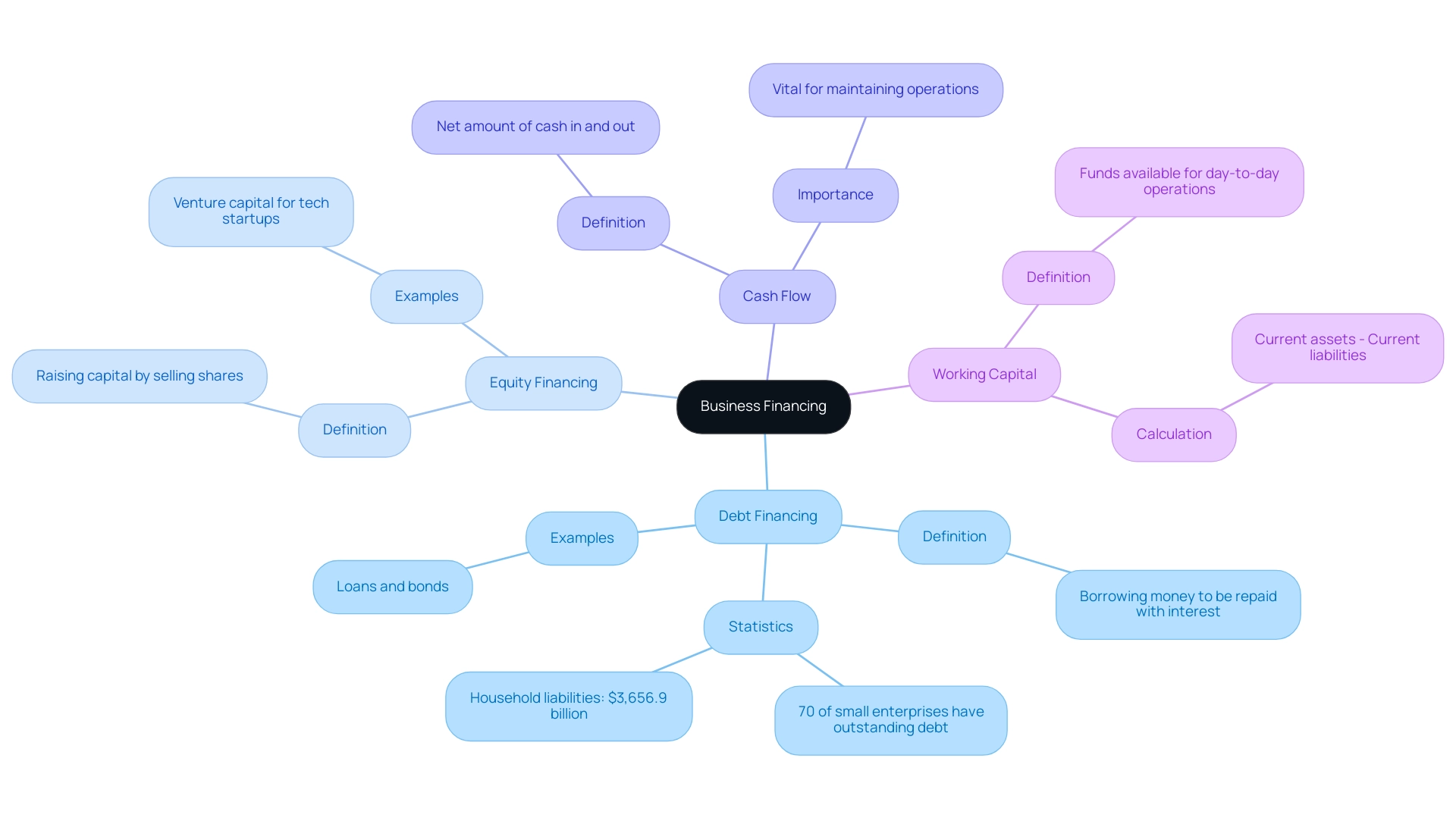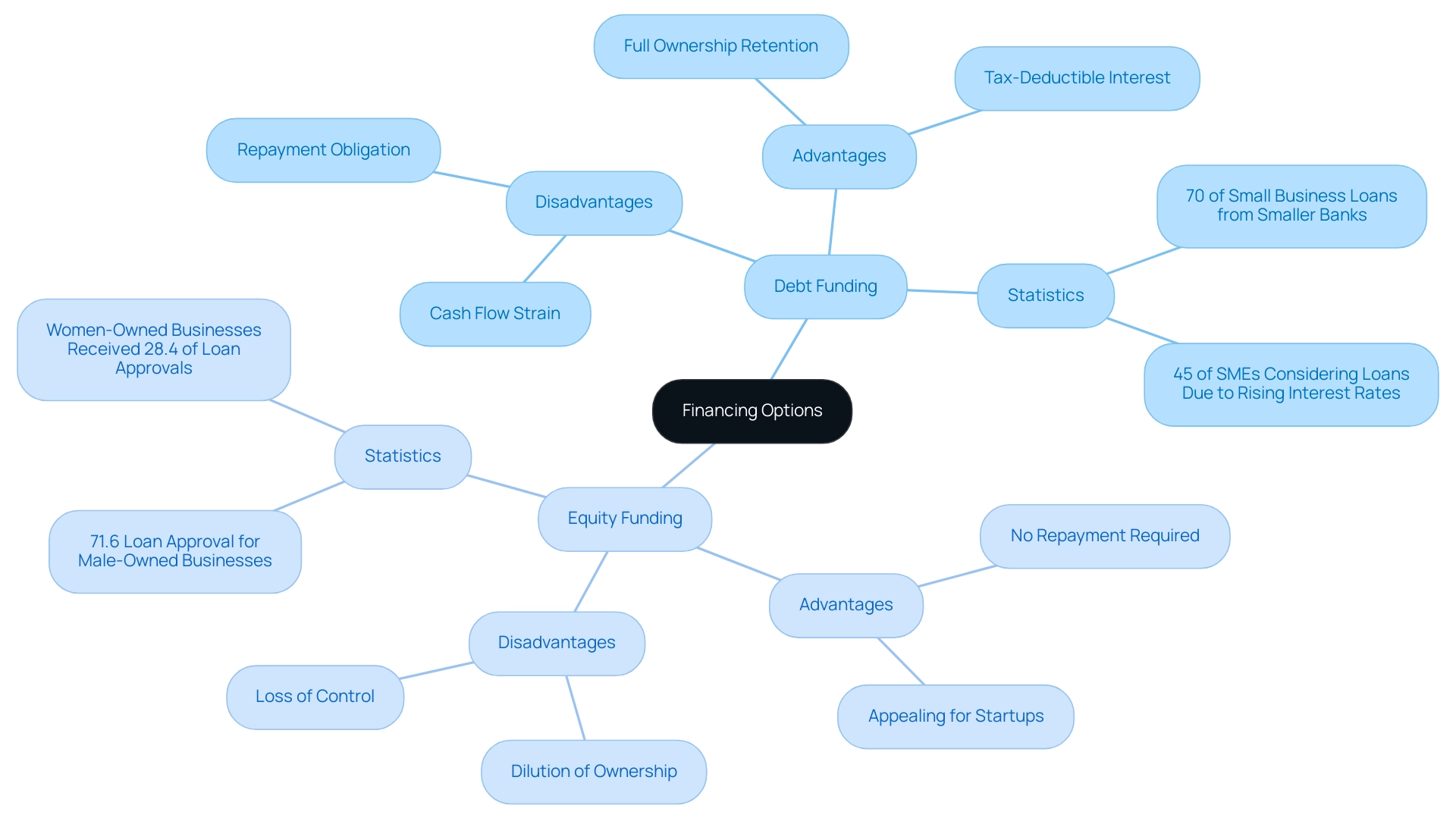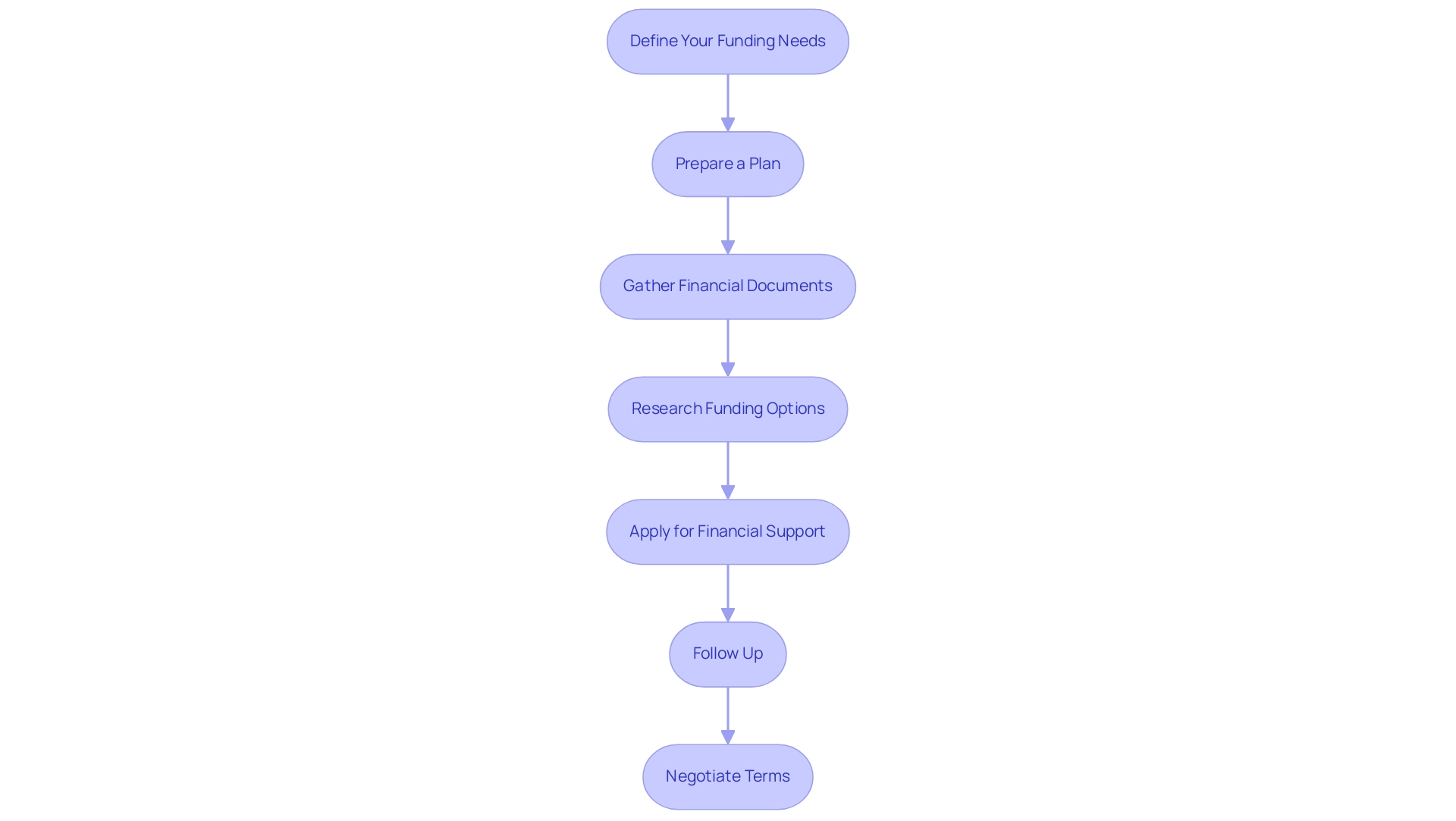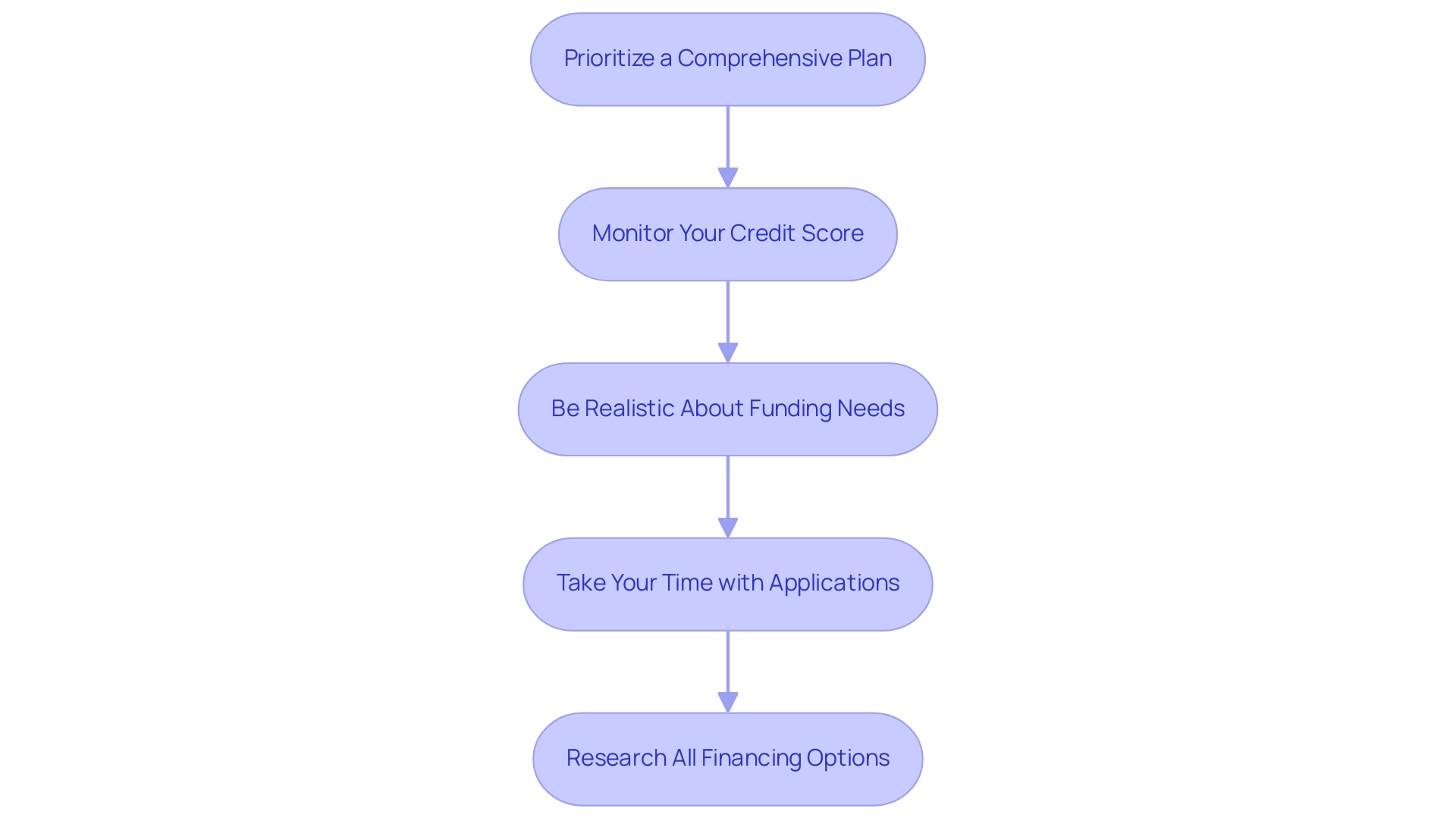Overview
To finance a business effectively, entrepreneurs must grasp various funding options, including debt and equity financing, while adhering to a structured process for securing capital. Understanding these elements is crucial. Key steps include:
- Defining funding needs
- Preparing a comprehensive plan
- Exploring diverse financing avenues
Furthermore, a well-informed approach can significantly enhance the likelihood of obtaining the necessary funds for growth and sustainability. Are you ready to take the next step in your funding journey?
Introduction
In the dynamic world of business, securing the right financing is crucial for unlocking growth and success. With a plethora of options available—from debt and equity funding to government grants and venture capital—understanding the nuances of each method is essential for any business owner.
This comprehensive guide delves into critical concepts of business financing, providing insights into:
- Assessing readiness for expansion
- Exploring various funding avenues
- Implementing effective cash flow management strategies
By equipping themselves with this knowledge, entrepreneurs can navigate the complexities of financing and make informed decisions that pave the way for sustainable growth. Whether you are a startup seeking initial capital or an established business looking to expand, the right financial strategy can make all the difference.
Understanding Business Financing: Key Concepts and Definitions
Understanding how to finance a business involves exploring various methods that enable enterprises to secure the necessary funds for operations, growth, and expansion. Grasping the key concepts in this domain is crucial for making informed financial decisions. Here are the primary funding methods:
- Debt Financing: This method entails borrowing money that must be repaid with interest, typically through loans or bonds. It allows businesses to access immediate capital while retaining ownership control. Notably, as of 2025, approximately 70% of small enterprises in the United States possess outstanding debt, according to Zippia, highlighting the prevalence of this funding approach. Moreover, household liabilities reached $3,656.9 billion, underscoring the significance of debt financing in the broader financial landscape.
- Equity Financing: This approach raises capital by selling shares of the company. While it dilutes ownership, it does not necessitate repayment, making it an attractive option for startups and expanding enterprises. Real-world examples include tech startups that secure funding through venture capital, enabling them to scale operations without the burden of debt.
- Cash Flow: This term refers to the net amount of cash being transferred into and out of an enterprise. Positive cash flow is vital for maintaining operations and ensuring that an organization can meet its financial obligations.
- Working Capital: Defined as the funds available for day-to-day operations, working capital is calculated as current assets minus current liabilities. Sufficient working capital is essential for sustaining operational activities and fostering growth initiatives.
Current trends indicate a growing demand for credit, driven by state government investments in transport, renewable energy, and major health projects. This environment presents opportunities for businesses to explore various funding options tailored to their specific needs. Finance Story distinguishes itself through its expertise in crafting customized loan proposals and funding solutions for commercial property investments and refinances.
For instance, when considering the purchase of a freehold property, understanding loan structures and leveraging property equity can significantly influence the funding process. By comprehending these essential concepts, entrepreneurs can navigate the intricacies of funding and learn how to finance a business, empowering them to make strategic choices that enhance their growth objectives. Furthermore, recent data indicates that dwelling commitments do not cover refinancing and encompass loans for construction, acquisition of new homes, and purchasing existing properties, providing further insight into the current state of the housing market and its implications for monetary options.

Assessing Your Business Readiness for Expansion
Before seeking financing, it is crucial to evaluate your enterprise's readiness for expansion by considering the following key factors:
- Market Demand: Conduct a thorough analysis to determine if there is sufficient demand for your product or service in potential new markets. Grasping market trends and consumer preferences is crucial, particularly as 78% of small enterprises have started adopting sustainability practices, indicating a transition towards ethical consumerism. This trend suggests that aligning your offerings with consumer values can enhance market demand. As Raja Abbas observes, the majority of small enterprises in Australia operate in the transport/warehousing sector, followed by retail and health care, which may influence market dynamics.
- Economic Well-being: Examine your monetary documents thoroughly to confirm your enterprise is profitable and that debt levels are manageable. Statistics indicate that 66% of small enterprises in the US experienced adverse effects from COVID-19, highlighting the significance of a robust economic foundation before seeking expansion. This underscores the necessity for data-driven decisions to assess your financial health accurately.
- Operational Capacity: Assess whether your current operations can accommodate increased production or service delivery. This includes evaluating your workforce, supply chain capabilities, and technology infrastructure to ensure they can support expansion efforts.
- Strategic Planning: Develop a comprehensive growth strategy that clearly outlines your goals, target markets, and resource requirements. A well-defined plan not only guides your expansion efforts but also serves as a critical tool when figuring out how to finance a business, as lenders often look for clear strategic direction.
- Risk Assessment: Identify potential risks associated with expansion, such as market volatility or operational challenges, and develop robust mitigation strategies. Comprehending these risks is essential for making knowledgeable choices and demonstrating to prospective lenders that you are ready for the hurdles of growth.
By carefully evaluating these elements, you can make educated decisions on how to finance a business, ensuring that your enterprise is well-prepared for successful expansion.

Exploring Financing Options: Debt vs. Equity Funding
When assessing financing alternatives, companies frequently face the crucial decision between debt and equity sources, each carrying unique implications for ownership and economic well-being.
- Debt Funding: This approach entails borrowing capital that must be repaid with interest. A primary advantage of debt funding is that it allows owners to retain full ownership of their company, which is vital for maintaining control over decisions. Additionally, interest payments on debt can often be tax-deductible, providing a financial benefit. As noted by Michael McCareins, "The best part? You don’t accrue debt at any point throughout the process since the company is purchasing your receivables." However, companies must prepare for the obligation of regular repayments, which can strain cash flow, especially during economic uncertainty. Recent statistics reveal that approximately 70% of small enterprise loans are offered by banks with less than $250 billion in assets, underscoring the critical role smaller banks play in economic funding. Furthermore, a significant 45% of SMEs are currently considering loans to manage the impacts of rising interest rates and inflation, reflecting a broader market trend.
For enterprises operating within a lease or those without a physical building, traditional commercial property financing may not be available. In such cases, options are limited to cash savings or leveraging equity from any owned property. For instance, if a home is valued at $1.3 million with $300,000 owed, borrowing up to 80% LVR could yield $740,000 in equity available for acquisition, supplemented by any cash savings. However, relying solely on cash savings or property equity can pose risks, such as potential liquidity issues or market fluctuations affecting property values.
- Equity Funding: This method involves selling shares of the enterprise to raise capital. While equity financing does not necessitate repayment, it results in the dilution of ownership, which may lead to a loss of control over essential decisions. This option can be particularly appealing for startups that may not yet have the cash flow to support debt repayments. However, it’s essential to consider the long-term implications of sharing ownership with investors. In 2022, a notable disparity was observed in loan approvals, with male-owned enterprises receiving 71.6% of loan approval amounts compared to 28.4% for women-owned enterprises, despite women owning 39.1% of small enterprises. This highlights the challenges women entrepreneurs face in securing financial resources and emphasizes the importance of exploring all available alternatives, including grants specifically designed to assist women in enterprise.
When choosing between debt and equity funding, consider your company's economic condition, growth strategies, and risk appetite. For instance, startups may benefit from debt strategies that allow them to leverage their receivables without accruing debt, as noted by industry experts. Ultimately, the choice between debt and equity financing should align with your organizational objectives and financial strategy, ensuring that you make an informed decision that supports sustainable growth.

Types of Financing Available for Business Growth
When it comes to funding alternatives for enterprises pursuing expansion, several avenues can be explored:
- Traditional Bank Loans: These long-term loans typically come with fixed or variable interest rates and often require collateral along with a solid credit history. While they can provide substantial funding, the stringent approval process can be a barrier for some small businesses. Notably, statistics indicate that 59% of SBA loans are approved, highlighting the potential for securing traditional financing despite challenges.
- Government Grants: These non-repayable funds are offered by government agencies to support specific projects or initiatives. They can significantly reduce financial burdens, but competition for these grants can be fierce, and the application process may be complex.
- Venture Capital: This involves investment from firms or individuals in exchange for ownership in the enterprise. While venture capital can provide not only funding but also strategic guidance, it often requires giving up a portion of ownership and control.
- Crowdfunding: This method permits enterprises to gather small sums of money from a vast number of individuals, usually via online platforms. It can be an effective way to gauge market interest and build a customer base, but success often hinges on a compelling pitch and marketing strategy.
- Invoice Financing: This option enables companies to borrow against outstanding invoices, enhancing cash flow without incurring additional debt. It can be a quick solution for companies facing cash flow challenges, but fees can accumulate if invoices are not settled promptly.
- Merchant Cash Advances: This involves receiving a lump sum payment in exchange for a percentage of future sales. It can be suitable for enterprises with fluctuating revenues, but the cost of capital can be significantly higher than traditional loans.
In addition to these options, organizations operating within a lease or without a physical building may need to utilize cash savings or the equity in any owned property for financing. For example, if an owner has a home valued at $1.3M with $300k owed, they could access up to $740k in equity to acquire a venture, supplemented by any cash savings. Furthermore, the emergence of non-bank lenders providing tailored loans and services to SMEs enhances access to finance with less collateral, particularly for leasehold enterprises.
Finance Story focuses on crafting refined and exceptionally tailored loan proposals for lenders, guaranteeing that companies can obtain the funds required.
Each funding option offers a distinct array of benefits and drawbacks, making it essential for owners to evaluate how to finance a business based on their specific situations and monetary requirements prior to deciding. For example, while traditional bank loans remain a popular option, recent statistics indicate that many small enterprises face challenges in securing these loans, particularly among women, minority, and veteran entrepreneurs. The examination of the lending environment for small enterprises highlights the significance of access to funding for entrepreneurial success, indicating that targeted support and education could enable these groups to navigate the financial landscape more effectively.
Comprehending these dynamics can assist entrepreneurs in understanding how to finance a business for their growth goals.
Step-by-Step Process for Securing Business Funding
To obtain financial support effectively, adhere to the following structured steps:
- Define Your Funding Needs: Clearly identify the amount of capital required and specify its intended use within your operations. This clarity will direct your financial strategy. Significantly, 70% of all small enterprises in the United States have outstanding debt, emphasizing the importance of comprehending your financial requirements.
- Prepare a Plan: Develop a comprehensive plan that articulates your model, includes a thorough market analysis, and presents realistic financial projections. A well-developed strategy is essential, as research shows that enterprises with comprehensive plans are 16% more likely to obtain financial support. Furthermore, sectors such as healthcare and social assistance exhibit the highest survival rates among small enterprises, which can affect financial choices.
- Gather Financial Documents: Assemble all necessary financial documents, such as tax returns, bank statements, and financial statements. Financial advisors emphasize that having these documents organized can significantly expedite the loan application process.
- Research Funding Options: Investigate various funding sources, including traditional banks, private lenders, and government grants. Grasping the landscape of available options will assist you in identifying those that best match your needs. Finance Story specializes in creating polished and highly individualized business cases to present to lenders, ensuring you have access to a full suite of financing options tailored to your circumstances, whether you are purchasing a warehouse, retail premise, factory, or hospitality venture.
- Apply for Financial Support: Complete applications for your selected financial sources, ensuring that all information is accurate and comprehensive. Attention to detail in your application can enhance your credibility with lenders.
- Follow Up: After submitting your applications, proactively follow up with lenders or investors. This demonstrates your commitment and allows you to address any potential questions they may have.
- Negotiate Terms: If your application is approved, engage in negotiations regarding the financial terms. Aim for conditions that align with your objectives and ensure long-term sustainability. Comprehending the repayment standards and conditions provided by various creditors is crucial for making knowledgeable choices.
By adhering to these steps, you can simplify the financing process and greatly enhance your likelihood of obtaining the required capital to expand your enterprise. With the right preparation and approach, navigating the complexities of financing becomes a manageable endeavor. Additionally, staying informed about industry trends, such as the ABS review of data collection in the survey, can encourage you to explore new funding opportunities.

Managing Cash Flow: A Key to Financial Stability
To ensure economic stability and foster growth, organizations must prioritize effective cash flow management through the following strategies:
- Monitoring Cash Flow: Regularly tracking cash inflows and outflows is essential for identifying trends and potential issues. This practice not only helps in recognizing patterns but also aids in making informed decisions that can enhance financial health.
- Creating Cash Flow Projections: Developing accurate cash flow forecasts is crucial for anticipating future cash needs. These projections allow organizations to plan for upcoming expenses and avoid cash shortages, ultimately contributing to long-term stability. In fact, companies that actively monitor their cash flow have a survival rate of 36%, underscoring the importance of this practice. Forecasting is essential for small enterprises to ensure sustainable growth and effective cash flow management, guiding them in making informed economic decisions and planning for future expansion.
- Optimizing Receivables: Implementing strategies to accelerate payment collection can significantly improve cash flow. For instance, offering discounts for early payments encourages clients to settle their invoices sooner, thus enhancing liquidity.
- Controlling Expenses: Regularly reviewing and managing expenses ensures that they align with revenue and cash flow projections. By identifying unnecessary costs, organizations can redirect funds towards growth initiatives and maintain a healthier cash flow.
- Maintaining a Cash Reserve: Establishing a cash reserve acts as a safety net for unexpected expenses or fluctuations in revenue. This buffer can be essential in navigating difficult economic times without jeopardizing operations.
By prioritizing these cash flow management strategies, organizations can strengthen their economic resilience and effectively support growth initiatives. For instance, a comprehensive cash flow projection can assist companies in making informed monetary choices, as emphasized in recent case studies on cash flow management tactics for small enterprises. As Jared Sorensen aptly noted, raising capital is one of the most critical challenges entrepreneurs encounter when starting or expanding a venture.
Therefore, mastering cash flow management is not merely a best practice; it is a fundamental element of achieving economic stability and success. Finance Story's professionalism and deep understanding of the finance sector further enhance its ability to assist clients in navigating these challenges effectively.
The Importance of Seeking Professional Financial Advice
Engaging a professional financial advisor, particularly from Finance Story, can significantly enhance your business's financial health and growth potential through several key benefits:
- Expertise in Financing: Financial advisors possess specialized knowledge and extensive experience in navigating the complex landscape of funding options and strategies. At Finance Story, we comprehend commerce like no other, ensuring that our insights assist you in making informed decisions that align with your goals.
- Tailored Solutions: Advisors excel at customizing options that cater specifically to your objectives and economic situations, particularly in teaching you how to finance a business. Our personalized approach at Finance Story ensures that you receive the most suitable funding options available, whether from our comprehensive panel of boutique lenders, private investors, or mainstream banks.
- Risk Identification: A crucial role of financial advisors is to identify potential economic risks that your business may face. We create proactive strategies to reduce these risks, protecting your economic future and ensuring you can handle even difficult situations.
- Monetary Literacy Enhancement: Working with an advisor not only provides immediate benefits but also improves your understanding of economic concepts. This empowerment allows you to make more informed decisions and encourages a culture of literacy regarding how to finance a business within your organization.
- Access to Funding: Advisors often have established relationships with a variety of lenders, facilitating introductions and negotiations. At Finance Story, our extensive access to various lending options allows us to guide you on how to finance a business, essential for small enterprises pursuing capital in a competitive market.
Investing in expert monetary guidance can enhance your understanding of how to finance a business, leading to more effective financing strategies and improved overall performance. For instance, a recent study highlighted that 1 out of 3 unadvised Australians reported enjoying a comfortable or lavish lifestyle in retirement, underscoring the importance of sound monetary guidance. Furthermore, Russell Investments found that advisors can add approximately 4.83% in additional annual value through services such as disciplined rebalancing and planning, illustrating the significant impact that professional advice can have on success.
The advisory industry, which employed nearly 1 million people in 2022, manages assets worth over $114 trillion, further emphasizing the value of professional guidance.
In summary, the advantages of pursuing expert monetary guidance are evident: customized solutions, risk management, enhanced economic literacy, and better access to resources can all contribute to your enterprise's growth and sustainability. At Finance Story, we take pride in our professionalism and thorough understanding of the finance sector, ensuring that we can assist small entrepreneurs in navigating their unique financial challenges and securing the best funding options available. As one pleased client, Natasha B. from VIC, stated, "I will definitely be recommending your services to anyone."
We are finished with the constant worry. Once again, thank you so much for being a part of our journey.
Avoiding Common Pitfalls in Business Financing
To successfully navigate the complexities of business financing and avoid common pitfalls, consider the following key strategies:
- Prioritize a Comprehensive Plan: A well-structured plan is essential for securing funding. It outlines your objectives and strategies while demonstrating to lenders that you possess a clear vision for your venture. Research indicates that companies with detailed plans are significantly more likely to receive financing. For example, JMA Credit Control's strategic planning enabled them to effectively recover unpaid debts, highlighting the importance of having a solid plan in place.
- Monitor Your Credit Score: Regularly checking your credit score is crucial. A poor credit score can lead to unexpected challenges when applying for loans, as many lenders view this as a critical factor in their decision-making process. In fact, late payments to small and medium-sized enterprises (SMEs) total nearly $3 trillion globally, negatively impacting over 30% of these companies. This statistic emphasizes the necessity of monitoring your credit score and managing your finances effectively.
- Be Realistic About Funding Needs: Accurately assessing your funding requirements is vital. Overestimating your needs can lead to unnecessary debt, straining your company's economic well-being. A clear understanding of your financial landscape will empower you to make informed decisions. If you operate a leasehold enterprise or lack a physical property, consider utilizing any available equity from properties you own or your cash savings to support your acquisition.
- Take Your Time with Applications: Rushing through the loan application process can result in errors or incomplete documentation. Ensure that all paperwork is accurate and comprehensive before submission to enhance your chances of approval. Approval rates for small loans are notably low, with large banks approving only about 13.8% of applications, while smaller banks and non-bank lenders exhibit slightly better rates.
- Research All Financing Options: Failing to explore various financing avenues can limit your choices and hinder your understanding of how to finance a business, potentially leading to unfavorable terms. By investigating various lenders and loan types, including the complete array of options offered through Finance Story, you can identify the best match for your needs. For instance, the Small Business Administration (SBA) typically offers higher approval rates compared to traditional banks. As noted by our team at Capital Bank, "we work hard to support as many small enterprises as possible, offering flexible loan options to our clients."
By being mindful of these pitfalls and implementing proactive measures, you can significantly enhance your chances of securing the funding necessary for your business's growth and success. Additionally, collaborating with experts like Finance Story can assist you in creating tailored loan proposals that meet the specific needs of your commercial property investments, including refinancing options for warehouses, retail premises, factories, and hospitality ventures, ensuring you have access to the right financing solutions.

Conclusion
Navigating the world of business financing is a multifaceted journey that demands careful consideration of various factors. Understanding the key concepts of debt and equity financing, assessing business readiness for expansion, and exploring diverse funding options are all integral to making informed financial decisions. Each financing method offers distinct advantages and risks; recognizing these can empower entrepreneurs to choose the right path for their unique circumstances.
Effective cash flow management is crucial for sustaining operations and supporting growth initiatives. By implementing strategies to monitor cash flow, create projections, optimize receivables, and control expenses, businesses can enhance their financial stability. Furthermore, seeking professional financial advice can provide the expertise needed to tailor solutions that align with specific business goals while identifying potential risks and opportunities.
Avoiding common pitfalls, such as underestimating funding needs or neglecting credit score management, is essential for securing financing successfully. A well-structured business plan and thorough research into available options can significantly improve the chances of obtaining the necessary capital.
Ultimately, the right financing strategy not only supports immediate growth but also lays the foundation for long-term success. By equipping themselves with knowledge and seeking expert guidance, entrepreneurs can confidently navigate the complexities of business financing and unlock their full potential for sustainable growth.




